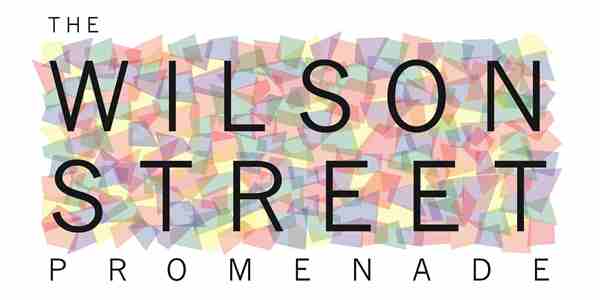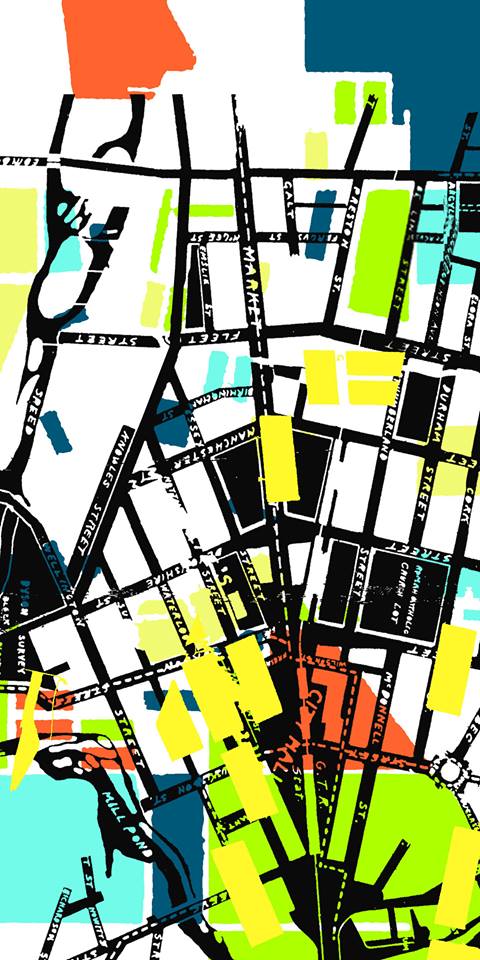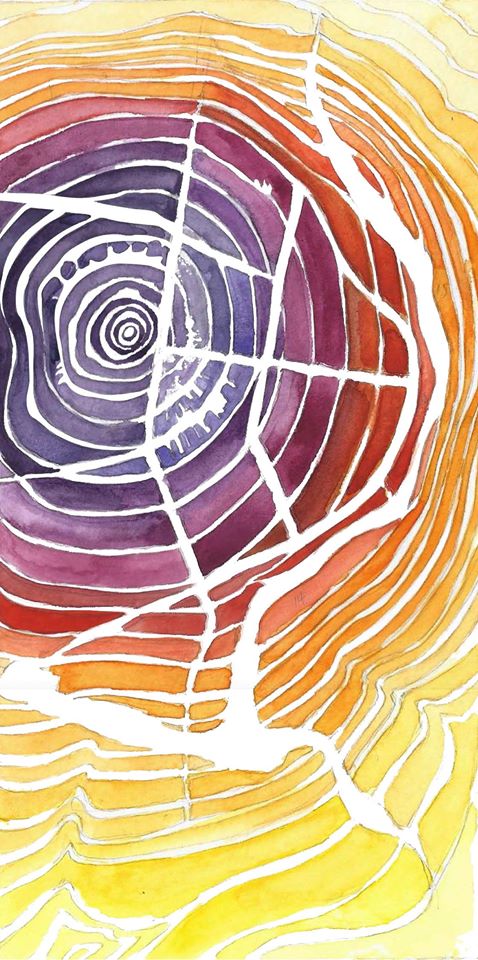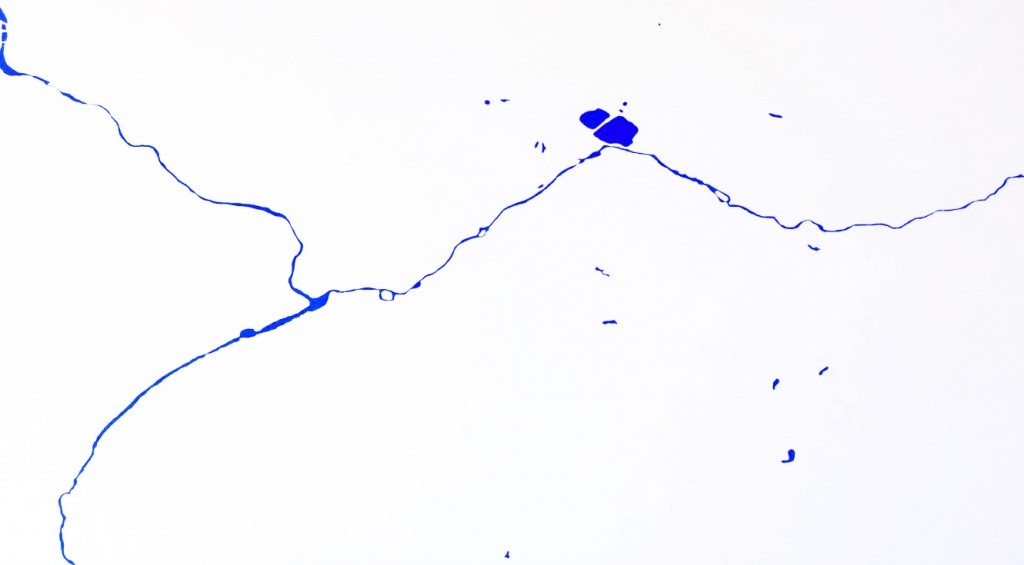On this page

The “Wilson Street Promenade” began as a project between two Masters of Landscape Architecture students at the University of Guelph.
The City partnered with Cyrille Viola and Calen Hamelin to present their urban design project which included a pop up park and beach, vendors from Guelph Farmers’ Market, temporary art installations, and activities for visitors.
This place-making initiative coincided with John Galt Day Festivities in Market Square on Saturday August 1, 2015 and was a great success.

Temporary art installations
“4380” by Natalie Schiabel
This piece of art created for The Wilson Street Promenade is an abstracted map of the City of Guelph. The first layer of colour is informed by a historical map of Guelph. Using components from this map, Natalie developed the locations for various areas of colour. The second layer of black squares and street markers takes its inspiration from a current map of Guelph, and the last layer is informed by a tourist map of the city. All these layers work together to create a composition that is both rich in information, but also visually abstract. The piece’s title, “4380,” is derived from the longitudinal and latitudinal location of the City of Guelph.
About the artist
Natalie Schiabel is a Toronto based artist with a background in architectural design and visual studies who will begin her Master of Landscape Architecture degree from the University of Toronto this fall. Much of her work is place-based, allowing her to explore individual characterizations of locations and destinations with various textures, colours and levels of transparency.

4380, Acrylic on Plywood, 4’ x 8’, by Natalie Schiabel, 2015.
“Ripples” by Arijit Debnath
In 1827, John Galt, a Scottish novelist and entrepreneur, saw a potential for growth and opportunity in a location in Ontario that was nestled between the eastern edge of the Huron Tract and York, at the confluence of the Speed and Eramosa rivers (Anderson/ Matheson, 2001). The presence of these elements enhanced John Galt’s vision for a city that would thrive on its own use of natural resources and agricultural growth. Born out of the innovative central radial design that respects as well as complements the surrounding topography, the city of Guelph flourishes in John Galt’s vision, with a thriving local economy that includes farmer’s markets, local businesses and top tier agricultural research facilities.This particular installation within The Wilson Street Promenade strives to embody the essence of that vision.The concept for “Ripples” uses familiar imagery of natural resources and the urban fabric of Guelph and recontextualizes these images to form new perspectives on our relationship with place and locality. The artwork repurposes cartographic forms of expression to explore ephemeral ways of conveying landscape and the non-material energy of space. Paying homage to the existing resource of oak, maple and ash trees in the surrounding greenbelt (Anderson/ Matheson, 2001), the curvilinear elements cascade from the central point in the form of tree rings- personifying growth, while the rippling quality speaks to the presence of the Speed and Eramosa rivers. Cutting through this symbology is a stripped down essence of the plan of downtown Guelph, bringing light to the radial design that is unique to the city’s urban fabric. The streets and ecology act as cracks through the natural growth, manifesting itself within the curvilinear forms and marking its presence and singular identity.
About the artist
Arijit Debnath is an illustrator and designer based in Toronto, Ontario.
References
Perspectives on a Century of Change in Guelph 1900-2000. Dawn Matheson, Rosemary Anderson, 2000. Guelph Historical Society.
“Speed Eramosa” by Luc Palmer
“Speed Eramosa” is composed of plaster and ink on a plywood base. The intention of the piece is to reveal the patterns and forms of landscape that surround us and our relation to them. Similar to other early Canadian cities, Guelph was located where two rivers met. Both the Speed and Eramosa rivers have shaped the way the city has organized and imposed itself on the landscape.
About the artist
Luc Palmer grew up in Vancouver and attended the University of Victoria where he received a Bachelor in Visual Arts and a Minor in Geography. During this time, he worked with common materials such as wood and metals to create large scale sculptures. Luc is now in the Masters of Landscape Architecture program at the University of Guelph. He has combined his two undergraduate degrees in the hopes of furthering his interest in the relation between landscape and people.
“The Colour of Stone” by Adrienne Hall and Owen McCabe
This installation takes a closer look at one of Guelph’s most ubiquitous and important natural materials – limestone.
Guelph is a city built both on and from its bedrock. Following its founding in 1827, Guelph’s growth was fuelled by limestone. Local quarries supplied a steady stream of rock that became the building block for some of the City’s most celebrated buildings – from the Church of Our Lady to stonemason cottages. Over one hundred and fifty years later, limestone architecture remains an integral part of the cityscape.
“The Colour of Stone” provides an abstract interpretation of the seemingly uniform colour of this local material in a subtle mosaic of coloured panels sampled from various limestone buildings in Guelph.
About the artists
Adrienne Hall
Adrienne Hall is an artist and designer practicing in Southern Ontario. Through installation, research, and writing, she creates work that explores individual and collective relationships to place and landscape, investigating perception, experience, self and sense of place. Adrienne received her Bachelor of Landscape Architecture from the University of Guelph.
Owen McCabe
Owen McCabe is a planner practicing at the regional-scale in the Greater Toronto Area. He utilizes photography and spatial data to explore urban spaces and their meanings. Owen received a degree in history from the University of Guelph and a degree in planning from Dalhousie University.



